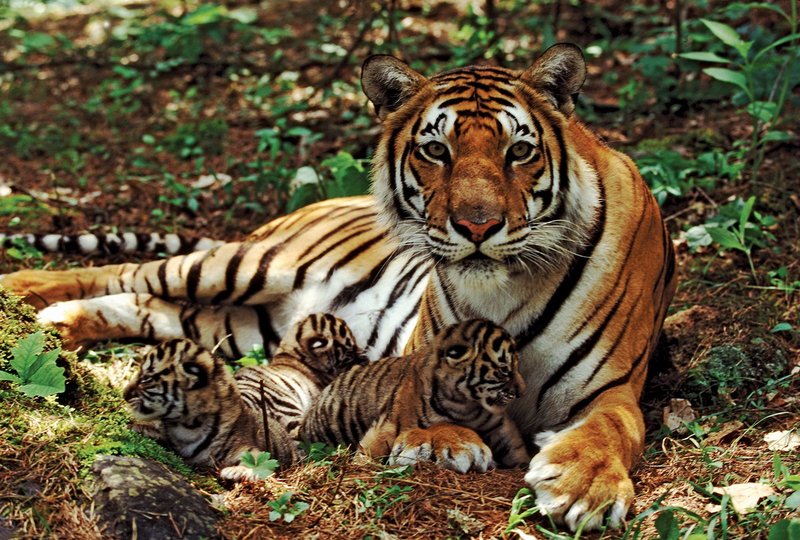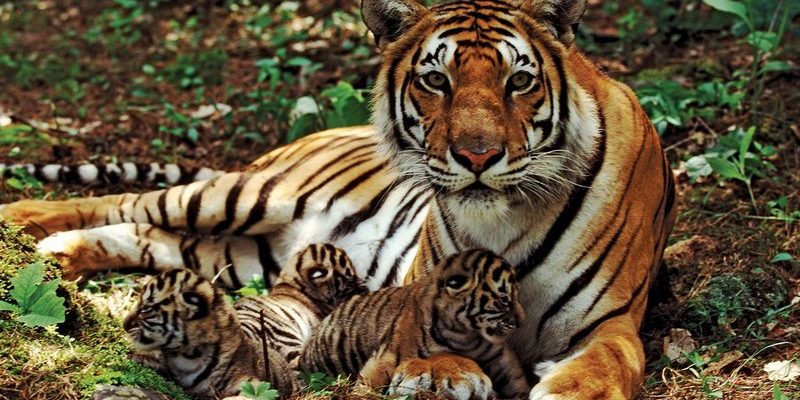
When it comes to raising their young, Bengal tigers use some pretty fascinating strategies. It’s a mix of instinct, learned behavior, and a little bit of luck. Tiger cubs are born blind and helpless, relying entirely on their mothers for survival during those vulnerable early weeks. Imagine raising your kids in a bustling city where every day comes with new challenges and threats—this is the reality for a mother tiger. She must protect her young from predators while also teaching them the skills they’ll need to thrive.
Let’s take a closer look at how Bengal tigers manage this daunting task.
Mother Tigers: The Primary Caretakers
In the animal kingdom, the mother often plays the most critical role in raising the young, and for Bengal tigers, this is no different. A female tiger, known as a queen, is usually a solitary figure, fiercely devoted to her cubs. After a gestation period of about 93 to 112 days, she typically gives birth to two to four cubs in a secluded den.
These dens can be hidden in dense vegetation or caves, offering a layer of protection from potential threats. Right after birth, the cubs are completely dependent on their mother for warmth, food, and safety. It’s almost like a new family starting off in a safe little bubble, where the outside world seems far away. The first few weeks are crucial, as the mother keeps her cubs tucked away, nurturing them in this safe haven until they’re strong enough to venture out into the wild.
The Importance of a Safe Den
A safe den is not just a luxury but a necessity. Mother tigers instinctively choose locations that are hidden and secure, protecting their newborns from both predators and unwanted attention. This careful choice is vital because the first weeks are a time of significant vulnerability.
Here’s where the queen’s instincts shine. She’ll find areas far from human noise and activity to ensure that her cubs can grow without disturbance. This protective environment allows her to focus on feeding and caring for her young without the constant stress of outside threats—kind of like a human parent choosing a quiet neighborhood for family life.
Nurturing Through Feeding
Feeding is one of the most fundamental parts of raising tiger cubs. Initially, the mother relies entirely on her own milk to nourish her cubs, which is packed with essential nutrients. For the first few months, the cubs don’t eat solid food; they depend entirely on their mother’s milk. Each feeding session isn’t just about nutrition; it’s also a bonding experience. The mother’s presence and warmth provide comfort to her cubs, crucial for their emotional development.
As the cubs grow and reach about two months old, they start to accompany their mother on hunts. This is a critical transition; it’s her way of teaching them about the food chain and survival in the wild. Imagine being shown the ropes of a family business—it’s that kind of learning, hands-on and experiential.
From Milk to Meat: Gradual Weaning
The transition from milk to solid food is gradual, taking place around two to three months of age. Bengal tiger cubs are introduced to small animals, learning to eat and chew as their mother brings back her kills. This step is crucial because it teaches them not just how to eat but also the importance of hunting skills.
You might be wondering how a mother tiger does this without overwhelming her little ones. Well, she’s patient. She often lets them play with small kills, encouraging them to practice their instincts without the pressure of a real hunt. This playful learning is a crucial phase, setting the foundation for their future independence.
Play and Learning: Building Hunting Skills
Playtime might seem like just fun and games, but it’s a vital aspect of a tiger cub’s development. Mother tigers encourage their cubs to play wrestle and chase each other. These interactions help the cubs develop the coordination and agility they’ll need for hunting later on.
During these playful moments, the cubs learn essential skills, like stalking and pouncing, which are critical for survival in the wild. The mother often participates in these activities, demonstrating moves and techniques that the cubs will one day need. It’s like a parent teaching their child how to ride a bike—there’s a balance of guidance and freedom to explore.
Social Structure and Competition
As they grow, tiger cubs start to recognize their place in the hierarchy of their family. They learn to compete for food and attention from their mother, which prepares them for the realities of adult life. The mother uses these moments to strengthen their instincts, allowing them to understand the nuances of social interactions in the wild.
This competition also teaches them resilience. Cubs that can assert themselves while still respecting their mother’s authority have a better chance of thriving as adults. It’s a blend of nurturing and tough love, much like how many parents balance kindness with teaching their kids about the world’s tough realities.
Independence: Preparing for Life on Their Own
By the time tiger cubs are around two years old, they begin to explore their independence. This is a natural progression, as they start to hunt on their own and establish territories. The mother, sensing their readiness, encourages this independence while still monitoring their development.
Imagine preparing a child for college—you want them to spread their wings but also be there for guidance. Similarly, the mother tiger will still check in on her cubs, ensuring they have the skills needed to survive. This transition is critical, as it teaches them how to navigate life in the wild without constant support from their mother.
Setting Up Territories
As the cubs grow older, they’ll need to establish their own territories to thrive. This involves understanding scent markings and recognizing other tigers’ boundaries. The mother plays a significant role in teaching her cubs not just the physical aspects of marking territory but also the social etiquette of the tiger world.
Once a cub leaves its mother, it must learn to navigate these territories on its own, which can be tough. Some cubs may stay with their mother longer, while others might explore early. It’s about finding their rhythm in the wild, where independence might mean survival or learning hard lessons.
Challenges in the Wilderness
Raising young tigers isn’t an easy task. The harsh realities of the wilderness pose numerous challenges. From food scarcity to human encroachment, mother tigers face a multitude of threats that can impact their ability to raise their cubs.
Human activities, like deforestation and poaching, add extra pressure. Sadly, this interferes with their natural habitats, making it even harder for mother tigers to find the resources they need. For every mother tiger trying to raise her young, there’s a constant battle against the odds, highlighting the need for conservation efforts to protect these beautiful creatures.
Survival and Adaptation
Despite the challenges, Bengal tigers have adapted over time. They’re territorial and solitary by nature, which can help them avoid conflicts with other big cats. Mother tigers instill this survival instinct in their cubs, teaching them to be cautious and aware of their surroundings.
Instincts play a significant role in their ability to thrive. Cubs learn to be wary of threats and to approach situations with caution. This adaptability is what makes Bengal tigers such fascinating creatures, and it’s a lesson in resilience for us all.
In the grand tapestry of nature, Bengal tigers’ ways of raising their young serve as a powerful reminder of life’s cycles. From the nurturing warmth of the mother to the playful exploration of cubs, each step is about survival and ensuring the next generation’s strength.
As we admire these magnificent creatures, let’s also reflect on the challenges they face. The story of how Bengal tigers raise their young is a testament to their resilience, adaptability, and the unwavering bond between mother and cub. Just like in our lives, parenting in the wild is less about perfection and more about love, learning, and survival—an intricate dance of nature that continues to inspire.

